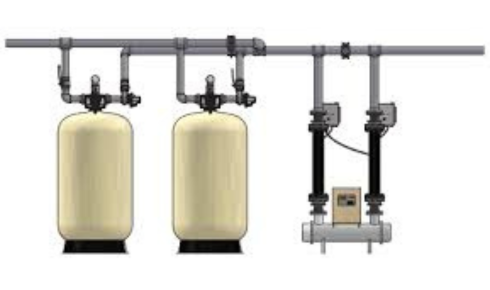If you’ve ever noticed your faucets developing a white crust, your freshly washed glasses turning cloudy, or your skin feeling dry and tight after a shower, you’ve probably met the not-so-friendly side of Texas water: hardness. It’s one of those quiet household problems that sneaks into daily life, wearing down appliances, pipes, and even patience. For many Texans, dealing with mineral-rich water is a way of life — but it doesn’t have to stay that way.
Hard water isn’t dangerous to drink, but it’s a real nuisance. It’s packed with calcium and magnesium, minerals that sneak into water as it moves through limestone and chalk underground. The result? Water that might taste fine but leaves behind limescale, soap scum, and buildup everywhere it flows. From clogged coffee makers to itchy skin, hard water doesn’t discriminate. And across Texas — from Austin’s Hill Country to the edges of El Paso — it’s a challenge that shows up in nearly every home.
Why Hard Water Is So Common in Texas
The geology of Texas almost sets the stage for it. Much of the state sits on limestone bedrock, which naturally seeps minerals into groundwater. It’s the reason many households experience higher hardness levels than the national average. Some areas even measure hardness levels of over 300 parts per million — that’s considered “very hard.”
So, while you might love the local barbecue or wide-open skies, the same Texas charm doesn’t extend to your tap water. The buildup from hard water can shorten the lifespan of dishwashers and washing machines, make detergents less effective, and even increase energy costs because water heaters have to work harder through the mineral coating.
That’s where hard water solutions Texas homeowners turn to come into play. Whether it’s a small under-sink system or a whole-home softener, there are plenty of modern ways to combat mineral-heavy water.
The Real Impact on Everyday Living
Most people notice the effects of hard water without realizing what’s causing them. Towels that feel rough? That’s mineral residue clinging to the fabric. Hair that looks dull even after a wash? Those same minerals are coating each strand. Even your shower doors might seem impossible to clean because the calcium buildup just won’t quit.
The issue goes deeper than appearance. Over time, hard water can corrode fixtures and clog pipes. This gradual damage can lead to expensive repairs or replacements that could’ve been avoided with the right system in place. And if you’ve ever tried to lather soap in hard water, you know it’s a losing battle. It takes more soap and longer rinsing, which means higher costs and wasted time — two things no one needs more of.
That’s why so many households are investing in hard water treatment systems designed to make everyday life easier and cleaner.
How Hard Water Treatment Works
The classic approach to softening water uses ion exchange — swapping calcium and magnesium ions for sodium or potassium ions. This process doesn’t just mask the issue; it actively removes the minerals responsible for water hardness. The result is softer, smoother water that feels better on your skin, helps soap lather more effectively, and protects plumbing and appliances from mineral buildup.
But technology’s come a long way. Today’s systems are more efficient, eco-friendly, and tailored to different home sizes and budgets. Some use salt-based methods, while others rely on salt-free or electronic conditioners that prevent scale from sticking to surfaces. For homeowners who prefer less maintenance, these systems are a godsend.
And it’s not just about comfort — it’s about long-term value. Softer water reduces maintenance costs, extends appliance life, and even helps clothes look brighter and last longer. When you add it all up, the investment often pays for itself in a few short years.
Choosing the Right System
Not all hard water issues are created equal. What works for a small home in Waco might not suit a sprawling property outside Dallas. The best approach starts with a water test — a simple, often free check that measures how hard your water really is. Once you know the hardness level, you can choose between different systems based on efficiency, regeneration frequency, and household size.
If your water hardness is high, a whole-house softener might be the best option. These systems connect to the main water line, ensuring every faucet and appliance receives treated water. For moderate hardness or smaller households, a point-of-use conditioner might do the trick.
Plenty of brands and installers across Texas specialize in hard water removal systems that fit different needs, from compact models for apartments to heavy-duty ones for rural homes on well water.
What Makes It Worth the Effort
It’s easy to overlook hard water as “just another home quirk.” But ask anyone who’s made the switch to soft water — it’s a game-changer. Dishes sparkle, showers feel luxurious, and laundry actually feels soft again. Even small things, like seeing your sink faucet stay shiny longer, make the difference worth it.
Besides, addressing water quality means you’re protecting your investment. Homes with water-softening systems often enjoy higher property value and fewer plumbing issues. Think of it as preventative care — like taking your car in for oil changes before it breaks down.
In a state as big and proud as Texas, there’s no reason to settle for hard water headaches when the fix is within reach.
A Final Thought
Living with hard water isn’t a necessity — it’s a choice. The minerals causing frustration in your home can be tamed with the right mix of technology and local expertise. And once you’ve experienced the difference, it’s hard to imagine going back.
So, if you’ve been scrubbing spots off dishes or replacing yet another clogged showerhead, it might be time to explore your options. The right water system can turn that constant battle into an easy, one-time decision that keeps your home running smoother for years to come.
Because at the end of the day, water should make life easier — not harder.

